System Disk Settings allows you to mirror system disks in a UFS boot environment.
System disks cannot be mirrored under the following conditions.
Change the disk configuration before performing the system disk settings.
The system disk's slice numbers are all in use, which means that the number of slices on the system disk has reached the upper limit (seven).
The system disk does not have sufficient free space or a swap area.
The system disk has a 2 GB or larger swap device in 32-bit Solaris.
For details on necessary free space (or a swap area), refer to "A.2.7 Disk Size."
Note
The setup for mirroring of a ZFS boot environment system disk cannot be performed from GDS Management View. For the setup method using commands, see "Chapter 7 How to Set and Cancel System Disk Mirroring Using Commands."
Note
Disk that will be mirrored by system disk settings
For system disk settings from the GDS Management View, disks with /, /var, /usr, and a swap area are recognized as system disks.
Disks that are recognized as system disks will automatically be the original disks for mirroring. Among /, /var, /usr, and a swap area, disks with only swap areas can be excluded from mirroring, but disks with /, /var, and /usr are always to be mirrored.
Also, physical disks that are not recognized as system disks cannot be mirrored using the [System Disk Settings].
Note
For Safe System Disk Mirroring
To safely mirror the system disk, exit all active applications before proceeding to system disk settings.
During the mirroring process, there may be a considerable degradation of application response time. After completing the system disk settings, promptly reboot the system.
Note
Confirmation before system disk settings
Before you configure the system disk settings, confirm and record the partition configuration and cylinder size of the system disk, and also whether or not MPxIO is enabled.
These information will be necessary for recovery when all boot disks physically fail or when the system cannot start due to some abnormality.
For how to confirm, see the step 1 and 2 in [Before the operation], "Resolution" for "(4) System cannot be booted (Failure in all boot disk devices)." in "F.1.5 System Disk Abnormality."
How to mirror a system disk
In the [Settings] menu, select [System Disk Settings].
Confirming original disks
Figure 5.13 Mirroring Disk Target List

In the [Physical Disk] field, system disks that will be used as original disks will be displayed with a check mark.
For disks with mount information in /etc/vfstab, the [Mount Point] field displays their mount points.
Original disks for mirroring with check marks in the [Physical Disk] field are registered as keep disks with the root class and mirrored.
Uncheck system disks not to be registered with the root class.
It is possible to uncheck system disks for which only swap among /, /usr, /var, and swap is displayed in the [Mount Point] field.
It is impossible to uncheck system disks for which /, /var, and /usr are displayed in the [Mount Point] field.
If not mirroring, click <Cancel>.
If mirroring, click <Next>.
Creating root class
Figure 5.14 Class Name Setting
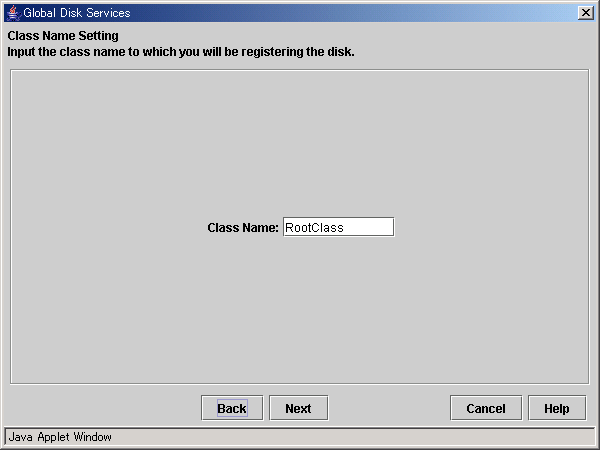
Type the class name of the root class.
If the root class is present, the class name cannot be set.
Information
Inputting the Class Name
The class name will be used for the device path name.
/dev/sfdsk/class_name/rdsk/volume_name
/dev/sfdsk/class_name/dsk/volume_name
You must be careful when inputting the class name, as once the volume is created, it cannot be changed.
Note
When Setting the System Disk in Cluster System
When setting the system disk in cluster systems, the class name of the root class should be different for each node.
See
For information on assigning a class name, see "A.1.1 Object Name."
Click <Next> to continue.
Creating group
Create the group by selecting the mirror disks.
When multiple system disks that will be used as original disks exist, perform group creation for every original disk.
Figure 5.15 Group Disk Selection: rootGroup
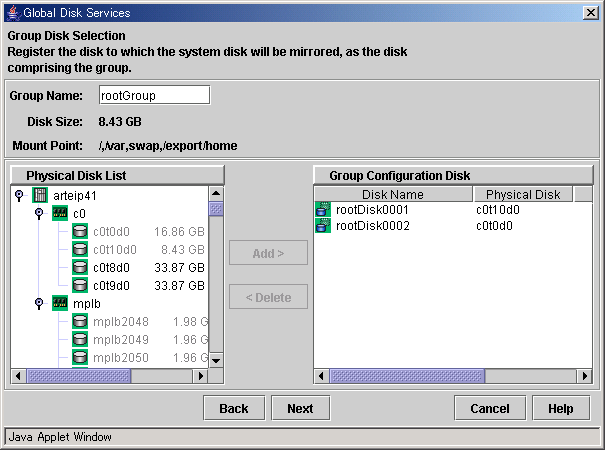
Group name, size and mount point will be displayed.
In the [Group Name], an automatically created group name appears as a default.
Change the [Group Name] if necessary.
In the [Group Configuration Disk] field, the original disk you selected will be displayed.
You cannot remove the original disk from the [Group Configuration Disk] field.
From the [Physical Disk List] field, select the mirror disk (i.e. the disk you want to mirror to) and click <Add>. The disk will be added to the [Group Configuration Disk] field.
You can select more than one physical disk at a time.
For mirroring disks, add one or more mirror disks. If no mirror disk is added, the original disk is registered with the root class and managed with GDS but will not be mirrored.
Double-click the [Disk Name] field in the [Group Configuration Disk] field, and change the name.
After adding all disks, click <Next> and create the next group.
Once you finish creating all groups, proceed to register the spare disks.
Note
Physical disks that can be registered as the Group Configuration Disk
GDS Management's system disk settings do not allow you to add a physical disk capacity that is smaller than the original disk. Users should always add a physical disk that is larger than the original disk.
Registering spare disk
Figure 5.16 Spare Disk Selection
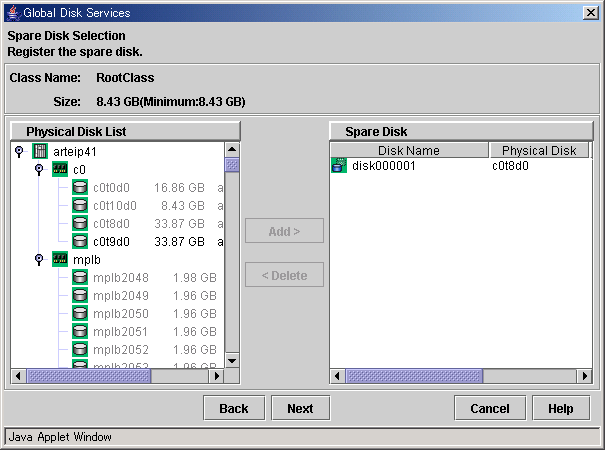
To register a spare disk, select the physical disk you want to set as a spare disk from the [Physical Disk List], and click <Add>.
Existing spare disks in the root class cannot be removed from the [Spare Disk] field.
After finishing the registration, click <Next>.
When you do not need to register a spare disk, no setting is necessary. Just click <Next>.
Point
Spare Disk Size
The hot spare function will not operate when there is not sufficient space on a spare disk to copy the configuration of volume in mirror group. Define the largest disk within the class as the spare disk.
Confirming system disk configuration
Figure 5.17 System Disk Configuration Confirmation
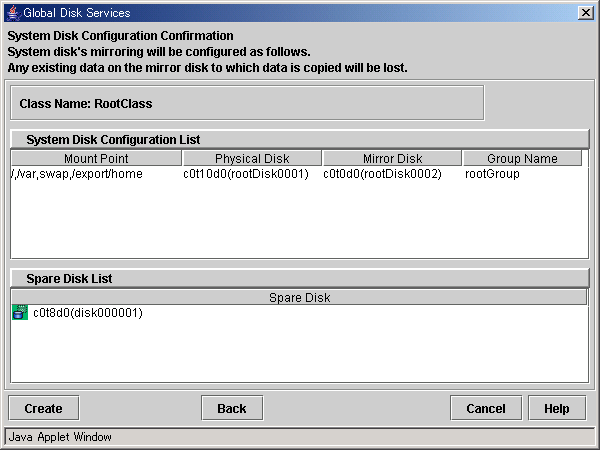
Confirm the system disk configuration.
In the [Physical Disk] field, the original disk will be displayed, and in the [Mirror Disk] field, the mirror disk will be displayed.
When mount information of a slice contained in physical disk is set for /etc/vfstab, mount point will be displayed in the [Mount Point] field.
Click <Create> to continue.
Information
Automatically Generated Volume Names
The following volume names are automatically generated when setting the system disk.
When mount information is set for /etc/vfstab, the name will be mount point + "Volume." (e.g. usrVolume) However, root partition will be rootVolume.
When mount information is not set for /etc/vfstab, the name will be "Volume" + number. (e.g. Volume0001)
Completing system disk configuration
Figure 5.18 Setting System Disk Mirroring Complete
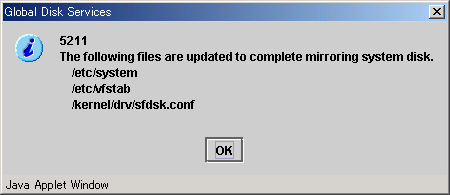
Confirm that the system disk configuration is complete, and click <OK>.
Figure 5.19 System Reboot Message

These system disk settings will be in effect after the system is rebooted. Click <OK> and reboot the system immediately.
Note
Rebooting the System after System Disk Settings are Completed
After the system disk settings are completed, if you change root class and system volume names before rebooting the system, the system may not be started. After the system disk settings are completed, reboot the system immediately without performing GDS setup, and so on.
Note
JRM and System Disk Settings
JRM (Just Resynchronization Mechanism) for a volume created by system disk settings will be set as "Yes."
To disable the JRM feature, select the volume in the Main screen and change the attribute by clicking [Change Attributes] in the [Operation] menu.
Note
Information collection after completion of the system disk settings
Back up the system disk after the system disk settings are complete.
Also confirm and record the class name and the physical disk name of the root class.
These information will be necessary for recovery when all boot disks physically fail or when the system cannot start due to some abnormality.
For details, see the step 3 to 5 in [Before the operation] "Resolution" for "(4) System cannot be booted (Failure in all boot disk devices)." in "F.1.5 System Disk Abnormality."